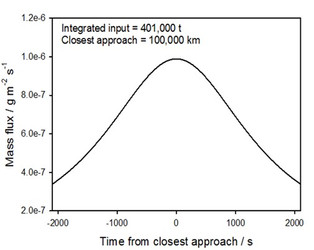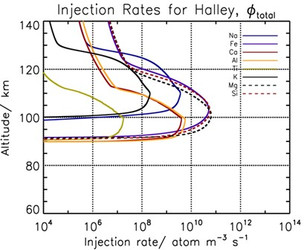Atmospheric Impacts of a Close Cometary Encounter
Middle/Upper Atmosphere Modelling, Current Research.
Global Climate Modelling
Although a close encounter with a comet is extremely unlikely, a significant perturbation to the flux of Earth-bound dust from a comet’s close passage could have huge implications for both the chemistry of the atmosphere and climate. For example, in A.D. 536, dark skies, reduced day lengths and a protracted global cooling were reported [1], for which an extraterrestrial disturbance may be at least partly responsible. Indeed, the recent encounter of Comet Siding Spring with Mars provided evidence that the risks posed by such an event are significant [2].
We have run sensitivity simulations using the Whole Atmosphere Community Climate Model (WACCM) with an elevated Meteoric Input Function (MIF) to investigate such an encounter – specifically, a close fly-by of Halley’s comet at a distance of 100,000 km. The simple analytical model developed by Moorhead et al. [3] has been incorporated into an atmospheric Chemical ABblation MODel developed at Leeds (CABMOD) to provide the MIF of several meteoric species (Na, Fe, Si, Mg and S) in the mesosphere and lower thermosphere (70-120 km) for input into WACCM. Key effects of this additional input on the chemistry of the upper atmosphere and the metal layers have been explored in the simulations and effects on mesospheric and stratospheric ozone chemistry have been assessed. In addition to any effects on atmospheric chemistry, WACCM will also be used to provide insight into the impacts of a high dust flux on the Earth’s climate.
 Dust flux experienced at the Earth during its path through the coma of Halley’s comet,
Dust flux experienced at the Earth during its path through the coma of Halley’s comet,
as calculated by the model of Moorhead et al. [2014]
 Meteoric ablation profiles for meteoric metals in the MLT, as calculated by CABMOD
Meteoric ablation profiles for meteoric metals in the MLT, as calculated by CABMOD
References
[1] Stothers, R. B. (1984), Mystery Cloud of Ad-536, Nature, 307(5949), 344-345.
[2] Schneider, N. M., et al. (2015), MAVEN IUVSMod observations of the aftermath of the Comet Siding Spring meteor shower on Mars, Geophys Res Lett, 42(12), 4755-4761.
[3] Moorhead, A. V., P. A. Wiegert, and W. J. Cooke (2014), The meteoroid fluence at Mars due to Comet C/2013 A1 (Siding Spring), Icarus, 231, 13-21
